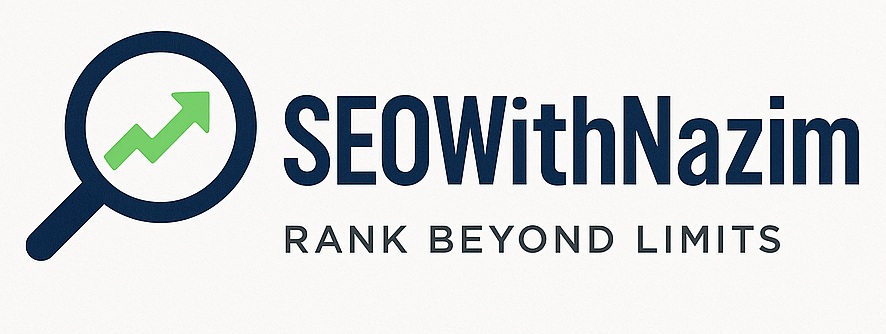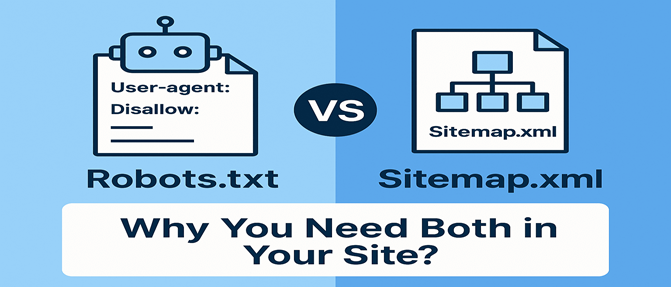Robots.txt controls crawler access by blocking unwanted pages, while Sitemap.xml ensures search engines find and index important pages. Robots.txt vs Sitemap.xml Together, they balance restriction and visibility, improving crawl efficiency, website indexing, and overall SEO performance.
🔑 Key Takeaways:
- A Robots.txt file controls crawler access and blocks unimportant or private pages.
- A Sitemap.xml file helps search engines find and index all important pages.
- Robots.txt vs Sitemap.xml differences: Robots.txt restricts crawling; Sitemap improves discovery.
- Using both together ensures efficient crawl budget and faster indexing.
- Common mistakes include blocking key pages or submitting outdated sitemaps.
- Best practice: test Robots.txt, keep Sitemap updated, and submit via Google Search Console.
Robots.txt and Sitemap.xml: What They Mean
A Robots.txt file is a simple text file placed at the root of your website. Its main role is to give instructions to search engine crawlers about which pages or sections should not be crawled. In short, Robots.txt meaning is about controlling crawler access and managing unnecessary requests to the server. For example, you can block pages with robots.txt if they are duplicate or private.
Sitemap.xml file is an XML-based file that lists your website’s important pages. The Sitemap.xml meaning is straightforward: it acts as a roadmap for search engines, helping them find and index your content more efficiently. The Sitemap URL structure usually includes categories, subcategories, and priority tags to show the importance of each page.
Why Sitemaps and Robots.txt Are Important in a Site
Both files play different but complementary roles in website indexing.
- Robots.txt importance lies in guiding crawlers. By telling search engines which areas not to access, it reduces unnecessary crawling and protects sensitive or irrelevant sections. Without it, crawlers may waste time on unimportant content. This can affect crawl budget, especially for larger websites.
- Sitemap importance is about discoverability. Even if a website has excellent navigation, some pages might remain hidden deep inside the structure. With a Sitemap.xml file, search engines get a direct list of pages, their update frequency, and their importance. This improves indexing efficiency.
If you rely only on a Robots.txt file, search engines may not discover all your content. If you use only a Sitemap.xml file, crawlers might still waste resources on sections that should not be indexed. That’s why both are necessary.
Together, they improve crawl efficiency, indexing speed, and overall SEO performance. They ensure search engines focus on what matters most while skipping unnecessary or restricted areas.
Robots.txt vs Sitemap.xml: Key Differences
Here’s a detailed comparison:
| Aspect | Robots.txt File | Sitemap.xml File |
| 1. Purpose | The Robots.txt file tells search engines which parts of the site should be crawled and which should be restricted. Its purpose is about control and managing access. | The Sitemap.xml file provides search engines with a structured list of important URLs. Its purpose is to ensure no key page is missed during crawling. |
| 2. Functionality | It blocks unwanted areas such as admin pages, duplicate content, or testing environments. The Robots.txt testing tool can check whether the rules are working correctly. | It lists URLs, along with metadata such as update frequency and priority. The Sitemap URL structure helps crawlers follow links systematically. |
| 3. Impact on SEO | Robots.txt importance is indirect. By blocking unnecessary crawling, it optimizes crawl budget and protects confidential pages. However, blocked pages may still appear in search results without content if linked externally. | Sitemap importance is direct. It helps search engines discover fresh and updated content faster, improving website indexing and visibility. |
| 4. Dependency | Works independently but is stronger when paired with a sitemap. Without it, crawlers may still index pages you want hidden. | Also independent, but more effective with robots.txt. A sitemap alone cannot block or restrict crawling. Both files complement each other. |
Summary: Robots.txt and Sitemap.xml differences show that one controls crawler behavior while the other improves discoverability. Used together, they balance restriction and visibility, leading to better SEO results.
How to Create an XML Sitemap
To create a Sitemap.xml file, you can use tools like Yoast SEO (for WordPress), Screaming Frog, or online sitemap generators. The file should include all important pages with proper Sitemap URL structure, such as categories, product pages, or blog posts.
Each entry can contain optional tags like <lastmod> (last modified date), <changefreq> (update frequency), and <priority>. Once created, place it in your website’s root folder and submit it in Google Search Console. This ensures better website indexing and crawl efficiency.
How to Create and Add a Robots.txt File to Your Site
Creating a Robots.txt file is straightforward. Open a plain text editor and add rules like:
User-agent: *
Disallow: /admin/
Disallow: /test/
This tells all search engines not to crawl admin or test pages. Save the file as robots.txt and place it in your site’s root directory (example.com/robots.txt).
After uploading, test it with a Robots.txt testing tool available in Google Search Console. This ensures your instructions are valid and correctly applied.
How Robots.txt and Sitemap.xml Work Together
- Guided Crawling – The Robots.txt file blocks irrelevant sections while allowing crawlers to focus on important areas.
- Complete Indexing – The Sitemap.xml file ensures all vital pages are discovered, even if they are deep in the site structure.
- Efficient Crawl Budget – Robots.txt saves resources by restricting access, while the sitemap directs those resources to valuable content.
- Faster Updates – A sitemap notifies search engines when content changes. Robots.txt ensures crawlers don’t waste time on unchanged or irrelevant pages.
- Balanced SEO Strategy – Used together, both tools reduce errors, prevent duplicate content issues, and improve website indexing.
In short, Robots.txt vs Sitemap.xml differences make them unique, but their synergy is what delivers strong SEO performance.
Best Practices for Robots.txt
- Place the file in the root directory.
- Use the Robots.txt testing tool before publishing.
- Block sensitive areas like admin panels, cart pages, and test environments.
- Avoid blocking essential resources (CSS, JS) required for rendering.
- Keep rules simple and organized.
Best Practices for Sitemap.xml
- Always keep the Sitemap.xml file updated.
- Use a clean Sitemap URL structure with logical categories.
- Include only index-worthy pages (avoid noindex or duplicate pages).
- Limit the file size (50,000 URLs or 50MB). Split into multiple sitemaps if necessary.
- Submit the sitemap to Google Search Console and Bing Webmaster Tools.
Common Mistakes to Avoid for Both Robots.txt and Sitemap.xml
| Mistake | Impact | Example | Fix |
| Blocking important pages with Robots.txt | Pages not crawled or indexed | Disallow: /blog/ | Remove restrictions from key sections |
| Adding duplicate URLs in Sitemap.xml | Wasted crawl budget | Two identical product URLs | Canonicalize or remove duplicates |
| Forgetting to test Robots.txt file | Crawlers may ignore rules | Typos in directives | Use Google’s Robots.txt testing tool |
| Submitting outdated Sitemap.xml | Search engines miss updates | Old pages still listed | Regenerate sitemap regularly |
| Blocking sitemap in Robots.txt | Prevents sitemap discovery | Disallow: /sitemap.xml | Ensure sitemap path is allowed |
Conclusion
- Both files are essential for SEO.
- Robots.txt importance is about controlling crawler access.
- Sitemap importance is about boosting content visibility.
- Together, they ensure website indexing is accurate and efficient.
FAQs:
Q1. What is Robots.txt meaning?
It’s a file that tells crawlers which pages to access or avoid.
Q2. What is Sitemap.xml meaning?
It’s an XML file listing key URLs for search engines to index.
Q3. Why is Robots.txt important?
It manages crawl budget and protects sensitive or irrelevant pages.
Q4. Why is Sitemap.xml important?
It ensures complete website indexing and faster discovery of pages.
Q5. Can I use Robots.txt and Sitemap.xml together?
Yes, they work best when combined for control and visibility.

Nazim is a Bangladesh-based SEO specialist with years of hands-on experience in organic search growth. He runs seowithnazim.com, a blog dedicated to simplifying SEO through tutorials, tools, and step-by-step guides. Nazim focuses on actionable, ethical strategies that deliver long-term results.


Leave a Reply